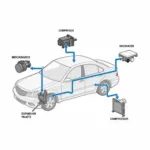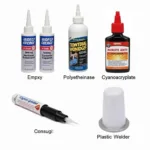A damaged bumper can be an eyesore and even affect your car’s resale value. Learning how to repair a car bumper yourself can save you a significant amount of money and is often simpler than you might think. This guide will walk you through various bumper repair techniques, from minor scratches to more substantial dents.
Repairing a car bumper can seem daunting, but with the right tools and a bit of patience, you can achieve professional-looking results. We’ll cover everything from assessing the damage to prepping the surface and applying the final touches. Whether you’re dealing with a plastic bumper or a metal one, we’ve got you covered.
Check out our guide on how to repair a car bumper yourself for a comprehensive overview of the process.
Assessing the Damage: Know Your Bumper
The first step in any car bumper repair is to thoroughly assess the damage. This involves determining the type of material your bumper is made of (plastic or metal), the extent of the damage (scratches, dents, cracks), and whether any underlying components are affected.
Identifying the Bumper Material
Most modern cars have bumpers made of thermoplastic olefin (TPO) or polyurethane (PUR). These plastics are flexible and durable, making them ideal for absorbing impacts. Older cars may have metal bumpers, which require different repair techniques. Knowing your bumper material is crucial for choosing the correct repair products and methods.
Categorizing the Damage
Damage can range from light scratches and scuffs to deep dents and cracks. Scratches can often be buffed out, while dents may require heat application or filling. Cracks, especially in plastic bumpers, can often be repaired with plastic welding or epoxy.
Repairing Minor Scratches and Scuffs
Minor scratches and scuffs can often be repaired with readily available products like rubbing compound and polishing compound. Start by cleaning the affected area thoroughly with soap and water. Then, apply the rubbing compound using a microfiber cloth, working in small circular motions. Follow up with polishing compound to restore the shine.
For deeper scratches, you may need to use touch-up paint. Ensure you choose the correct paint code for your car to achieve a seamless match. Apply the paint in thin coats, allowing each coat to dry completely before applying the next.
Looking for a quick fix for those pesky scratches? Read our guide on how to repair a car bumper scratch.
Repairing Dents in Plastic Bumpers
Dents in plastic bumpers can sometimes be repaired with hot water. Carefully pour boiling water over the dented area from the inside of the bumper (if accessible). The heat can cause the plastic to regain its original shape. However, this method isn’t always effective, especially for deep or complex dents.
For more persistent dents, you might need to use a heat gun or a hair dryer. Apply heat to the dented area while gently pushing the dent from the inside. Be careful not to overheat the plastic, as this can cause it to melt or warp. You can learn more about this technique in our article on how to repair a car bumper with hot water.
Repairing Cracks and Holes
Cracks and holes in plastic bumpers require more advanced repair techniques, such as plastic welding or using epoxy. Plastic welding involves melting filler rods into the crack or hole to create a strong bond. Epoxy can also be used to fill cracks and holes, but it may not be as durable as plastic welding.
Finishing Touches
After repairing the damage, you may need to sand the area smooth and apply primer before painting. This will ensure a professional-looking finish. Always remember to wear appropriate safety gear, such as gloves and eye protection, when working with chemicals or power tools.
John Smith, a seasoned auto body technician with over 20 years of experience, advises, “Patience is key when repairing a car bumper. Take your time and follow the steps carefully to achieve the best results.”
Conclusion
Repairing a car bumper can be a rewarding DIY project that saves you money and gives you a sense of accomplishment. By following the steps outlined in this guide, you can tackle various bumper repairs, from minor scratches to more substantial damage. Remember to always prioritize safety and take your time to achieve the best possible outcome. For specific regional repair services, you can search for options like a car bumper repairer carnforth. If you’re unsure about any step, consult a professional for guidance.
FAQ
- Can I repair a cracked bumper myself?
- What tools do I need for bumper repair?
- What type of paint should I use for touch-ups?
- How do I prevent future bumper damage?
- Is it cheaper to repair a bumper or replace it?
- Can a dented bumper be repaired without painting?
- How long does a bumper repair typically take?
Looking for more information on repairing dents? Check out our guide on how to repair a car bumper dent.
Need further assistance? Contact us via WhatsApp: +1(641)206-8880 or Email: [email protected]. Our customer support team is available 24/7.


